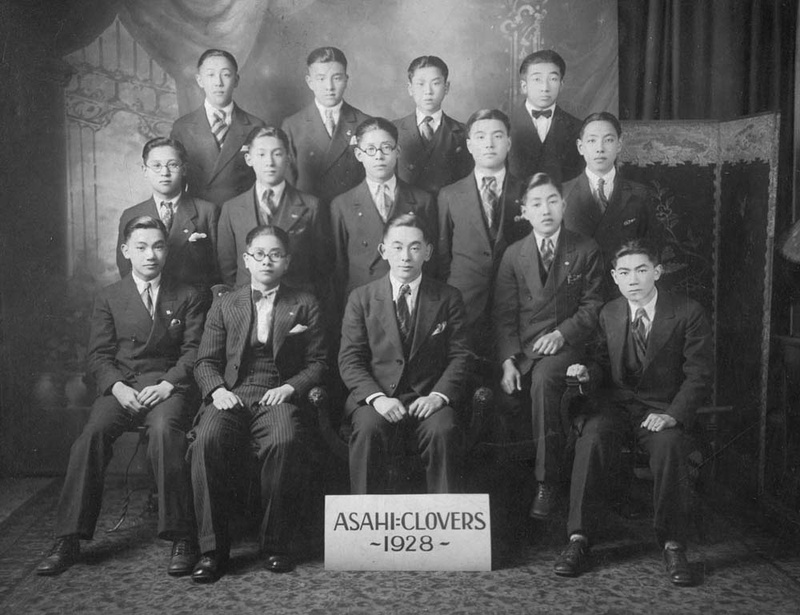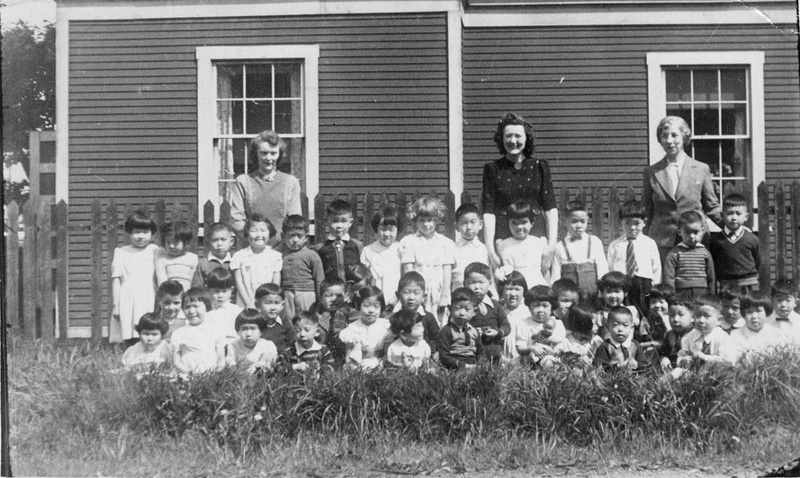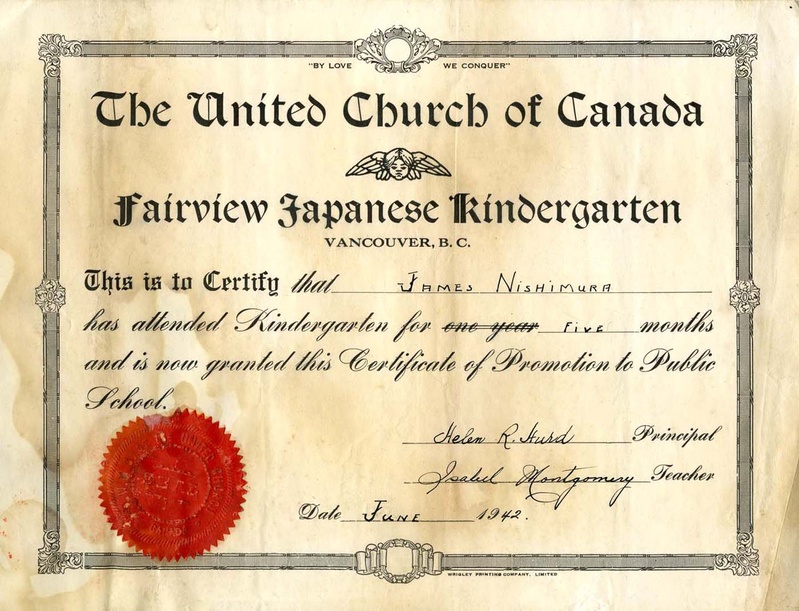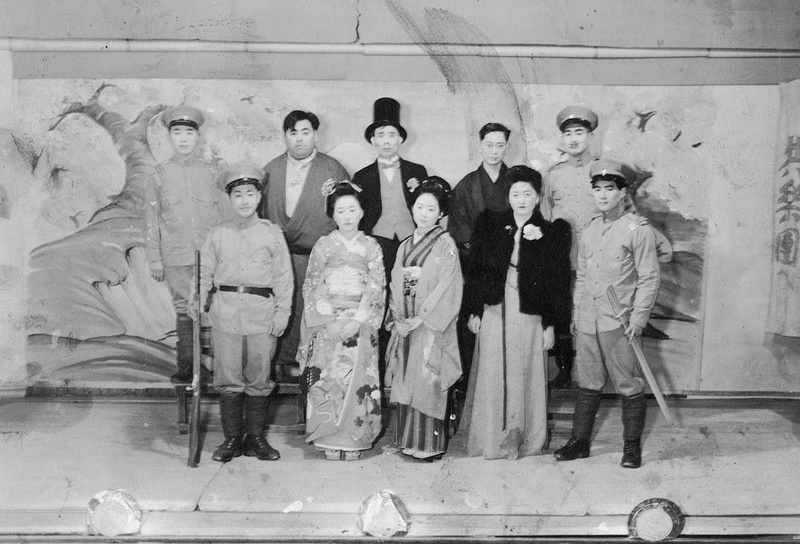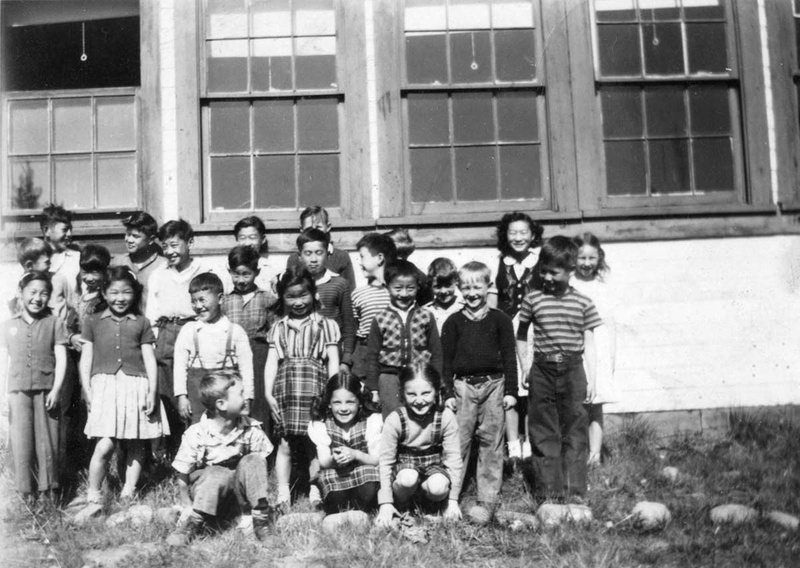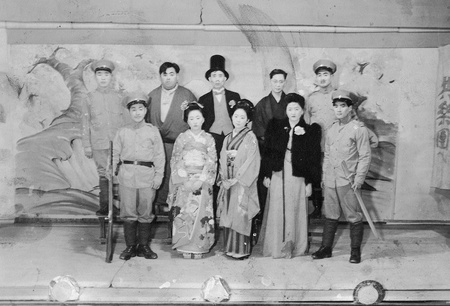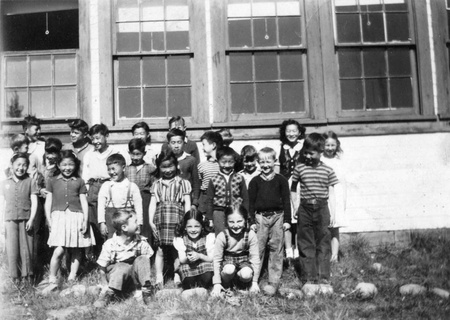My father, Gengo (Jack) Nishimura (1910–1982), and my mother, Yuki (née Saiki) (1915–1949), were Vancouver-born Nisei. My dad’s family was from Shiga-ken and my mother’s was from Fukuoka-ken.
Before the war, we lived in the Fairview area of Vancouver where my dad had a dry-cleaning establishment. I attended the Japanese kindergarten run by the United Church of Canada in Fairview. I still have this certificate of promotion to public school which was signed by Helen R. Hurd, the principal, and the teacher Isabel Montgomery, dated June 1942.
This must have been about the time we left Vancouver by train to Hope. From Hope we had to ride on the back of a truck to a place called Tashme. We only had a few suitcases and a big steel trunk, which I still have to this day. I think we still have pictures in the trunk of some of the people that played in the Japanese concert during our stay in Tashme.
I don’t remember how they selected which Avenue you lived on or which house you lived in, but we were assigned to live in the last house at the end of 9th Avenue. The community bathhouse was across the street from us and I remember it was very noisy because people were going to the bath house on the wooden sidewalk with their wooden geta (Japanese slippers). We had a young lady teaching Japanese class in our house after English class. We were lucky not to have a house fire on the Avenue as the whole block would have gone up in flames with all the houses joined together by a wood shed. I remember there were two outhouses behind our house with four doors and another outhouse to the side of us. I believe two families shared one unit. We all had a small garden plot to grow vegetables. We weren’t allowed to fish in the area.
We went to watch baseball games in the summer, but I don’t remember what we did during the winter. There was a large Boy Scout troupe and occasionally they would march down the street carrying lanterns. It seems Tashme was a place for people moving into, or out to other places in the interior. We moved out of Tashme around 1945 to a place called Brookmere where my dad was asked by Mr. Gillis, a sawmill owner, to gather other families who wanted to work in the mill. Some of the people who went were Kazuta, Miyazaki, Yasunaga, Mori, Otsu, Ishikawa, Hayakawa, Iwanaka, Murata, Kaniyama, Uchida, Fujisawa, and Yoshikawa.
I did not experience any racial discrimination at Brookmere, probably because there were mostly Japanese students in the one-room school that had grades from one to eight. We never heard anything about the war between Japan and Canada as nobody spoke about it, at least to us kids. We were treated really well by everyone who lived there. We went fishing, swimming, and horseback riding in the summer. There were about 1,500–2,000 sheep that came by our house in the spring and back in the fall that came from the Douglas Ranch by Aspen Grove.
The sawmill owner treated all of us really well. The house we had built was a lot warmer than the one in Tashme and had more rooms along with our own private outhouse. Harold Sato’s dad worked for the CPR and the family was in Brookmere before us and lived on the other side of the tracks. Some families would make extra money by peeling the bark off the pine trees for mine poles that were about 6-feet long and 6-inches in diameter, which was really hard work.
After the sawmill closed in Brookmere, my dad went to Tulameen and met with the mill owner, Grant Squelch, who asked dad to bring his family and any friends who may want to work at his sawmill. About six families came with us, while some went to Merritt and others from Tashme moved out East or to Japan. We were treated very well by Mr. Squelch and were given a nice log home with four rooms. It was like a mansion compared to the shacks we had previously lived in. It had a sawdust burning stove with a hopper on the side that we filled at night and kept us warm until morning. The sawdust was delivered free from the mill—no more chopping wood. The rural school was from grade one to eight and had about twenty-five students.
In summer, we spent most of our time at Otter Lake which was only about a mile away. Fishing was good at the lake and also at the outlet of the Similkameen River. Our biggest trip was going into Princeton once a month to watch a movie. The trip was about eighteen miles but it took us over one and a half hours by the only taxi in town, a model T Ford. The sawmill workers would take the taxi to the beer pub in Coalmont on the weekends which was only five miles away. On July 1st, all the Japanese families got together for a picnic at the Similkameen River. Our summers were busy fishing, hiking, horseback riding, and hunting. I had a 22 semi-automatic rifle and hunted mostly grouse and pheasant.
Every Thanksgiving we entered the turkey shoot that was held at Mr. Rabbit’s farm. The Japanese Canadian guys I knew were Elmer and David Mori, Jim Nishihara, and Mickey Yasunaga. I played mostly with the white boys and was treated equally with no racial slurs. During the winter we had ski hills and the lake was one big skating rink. The Canadian Pacific Railway trains would come to the lake and workers would cut blocks of ice and load them into the box cars. Sometimes we would take the train into Princeton.
The saddest moment of my life was coming home for lunch and told that my mother had passed away at the Princeton Hospital on April 5, 1949. She was only thirty-four years old; I was thirteen, my sister Jane was eleven, and my two younger brothers, Kenny and Yoshiyaki (Chaki), were seven and five so they did not remember very much. My mother was giving birth and had some complications. The regular doctor was away on a call so the intern was the only medical person on duty. I often thought that had we lived in Vancouver my mother might have survived, however our baby sister, Esther, survived. Consequently, all five of us children lived with the Hughes family where Mrs. Hughes looked after us as well as her own three children.
After the Tulameen sawmill closed, dad went to Penticton to look for a sawmill job and the owner asked him if there were any other Japanese families willing to work at his mill. We stayed with the Hughes family for about two or three months then we moved to Penticton. Only the Mori family went to Penticton and we stayed with them and lived in the sawmill owner’s big home.
At this point with four young children already, dad had no choice but to give up our baby sister, Esther, for adoption to a Japanese couple in Lethbridge. We went to see her when she was about 18-years old in Lethbridge and had a great reunion. Esther has since married into a family with two sons and lives in Richmond, B.C.
The Japanese Canadians were allowed to return to the West Coast in 1949 and my father came back to Vancouver to look for work in April 1950. Two months later we joined him and stayed with the Iwata family at the Hotel Roosevelt. After living with the Iwata family for two to three months we moved to an apartment at 430 E. Cordova which was in front of the Powell Street grounds.
My sister Jane, brother Ken, and myself attended Strathcona School, whereas my youngest brother Chaki, went to the Catholic kindergarten run by the Franciscan Sisters. However after a week of crying everyday at kindergarten, my dad felt sorry for him and asked the principal of Strathcona School if Chaki could go to school with his brothers and sister, which he consented to. There were not too many Japanese Canadian students at school at that time so I had a few fights at school when called a “Jap.”
Later on I was befriended by a couple of white guys with whom I played soccer, baseball, and boxing. The Japanese Judo Club started at the Japanese Language School in the early 1950s and I got to meet many Japanese Canadian boys as we had tournaments in Steveston and in Seattle. We also started the Japanese Nisei Teenage Club that held lessons and dances at the Vancouver Japanese Language School and also organized ballroom dances at the Hastings, Peter Pan, Arlington, and Pender Auditoriums that brought many Japanese Canadians of all ages together. I think I still have my membership card to the Club.
In the early 1960s many Japanese Canadians joined the Nisei Bowling league which was held on Saturday evenings at the Commodore Bowling alley on Granville St. After bowling many went to the movie theatres nearby and possibly met their future partners. There were about 100 Japanese Canadians including Issei, Nisei, and Kikka Nisei which took up the whole alley. Some of my Caucasian friends asked if they could join but were discriminated against as the league was only for those of Japanese descent. A lot of credit must go to Nobby Fujisawa, Gordon Mayede, Kaz Nakamoto, and Mits Nozaki who organized the league. These events brought many Japanese Canadians together.
Many of us attended the Japanese Language School which taught us the basic hiragana and katakana and some kanji as well as learning to speak better Japanese. I joined the Vancouver 2nd Scout Troop and had our meetings at the First United Church at Hastings and Gore Ave. with Scoutmaster Lambert. I still remember going swimming at Crystal Pool in English Bay with the scout troop and was denied entry because I was of Japanese descent. What made my day was, when the others came out and asked the ticket person why I was not allowed in and when they were told why, the troop asked for a refund and they all walked out. Our scoutmaster was a very fair person who treated us all equally.
In the early 1950s, more Japanese families moved into the Powell Street area, such as the Kazuta, Uchida, Kamiya, Kagetsu, Nishi, Kunimoto, and Sato families to name a few. Powell Street also had many Japanese businesses to serve our community. After I left Strathcona School in grade 8, we moved into an apartment at Cordova and Heatley St. About a year later my dad was able to have his mother come over from Japan with special assistance from a local MLA to help look after our young family.
I started high school at Vancouver Technical School on Broadway St. I caught the street car on Hastings St. which took me to Commercial and Broadway and then transferred onto the Broadway bus to school. Our classes were all boys in technical classes taking woodworking, electrical, sheet metal work, printing, and drafting courses. We could start with four different technical courses and after four years you ended up taking one course that you liked until you graduated.
My first summer job was strawberry picking in Richmond at age 14. We would catch our bus on Powell St. and pick up other Japanese workers along the route. The following year George Iwata and I picked strawberries and put up bean poles at Mr. Katsumoto’s farm in Aldergrove. We would often go about half a mile to the Ishikawa family’s house to have a Japanese bath. Next door to the Katsumoto’s was the Okabe farm where a group of teenage girl berry pickers were hired, including my future partner.
Another summer job was working as a laborer for Hirano Construction in West Vancouver building houses. I would catch the West Van blue bus with Mr. Mike Oikawa who was a carpenter. I also remember working with Kaz Tasaka and Mr. Shimizu in construction. Mr. Hirano also put on Japanese movies at the Olympia Theatre on Hastings St. One of the best summer jobs I had was working for the Canadian Fishing Company at the foot of Gore which helped pay for my education. I met a lot of Japanese Canadian there and Mr. Kamikura was our foreman who looked after most of the Japanese Canadian workers. He would let us know when to start the next morning and roughly how many hours for the day and was very fair to all of us. We were paid $1.35 per hour and after 8 hours we would be paid time and a half and some days we had to work 14 hour shifts. We were paid cash on pay day which was great. I remember going to the Sun Peking Restaurant on Powell Street when we worked overtime for some of the best soba noodles in town as well as many other delicious entrees at reasonable prices.
After graduating from Vancouver Tech with fellow Japanese Canadian students, Ruby Okano and Louie Hori, we moved to 2682 Franklin Street which was our first detached home. Our neighbors on one side were the Naganos and on the other side were the Yanos and Inamasus. My father was working in partnership with Mrs. Iwata and her sons, Art and Sid, at Perfect Cleaners located at Hastings Street and Clark Drive. They did dry cleaning for twenty to thirty Press shops, many of which were Japanese-owned. I remember a few shop owners, such as Mori, Tahara, Tasaka, Otani, and Ukai. I started my first job in 1956 after graduating from Vancouver Tech in 1954, working for Tessler Bros., a dry cleaning supply firm.
I married Yoko Hayashi in 1961 and had three sons, Derek, Todd, and Neil. I worked at Tesslers until 1972 and then for Harrison & Crosfield in the same line of business until 1991. I also worked at George Wertman, B.C. Specialties and lastly at Prairie Distributors until I retired in 2001. I now have a part time job marshalling at Langara Golf Course which allows me to make trips to Las Vegas.
*This article was originally published in Nikkei Images, a Publication of Nikkei National Museum & Cultural Centre Vol. 18, No. 2 Summer, 2013).
© 2015 Nikkei National Museum & Cultural Centre


